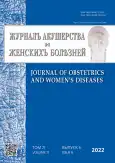Small intestine prolapse after vaginal hysterectomy with vaginal dome rupture. A clinical case
- Authors: Ziganshin A.M.1, Mukhametdinova I.G.1, Allayarova V.F.2, Shayhieva E.A.3
-
Affiliations:
- Bashkir State Medical University
- City Clinical Hospital No. 13
- Republican Medical Genetic Center
- Issue: Vol 71, No 6 (2022)
- Pages: 107-112
- Section: Clinical practice guidelines
- Submitted: 27.10.2022
- Accepted: 24.11.2022
- Published: 07.02.2023
- URL: https://journals.eco-vector.com/jowd/article/view/112118
- DOI: https://doi.org/10.17816/JOWD112118
- ID: 112118
Cite item
Abstract
The relevance of surgical treatment of pelvic organ prolapse is beyond doubt, due to the high prevalence and risk of surgical intervention during life. Surgical treatment of prolapse today remains the only effective method, however, despite more than 400 methods of surgical correction, the number of complications and relapses does not tend to decrease.
This article presents a clinical case of ineffective choice of surgical treatment of genital prolapse with own tissues and vaginal hysterectomy, which subsequently led to the development of enterocele. In the future, the lack of postoperative follow-up and the preservation of a lifestyle that included the performance of hard physical labor led to a rupture of the dome of the vagina and prolapse of the loops of the small intestine.
Today, for the prevention of complications and recurrence of genital prolapse, it is mandatory for patients to go through a careful selection for surgical treatment, which should include a clinical study and study of risk factors. When choosing an operative approach, complex treatment is necessary, including the use of the patient’s own tissues and modern materials that allow creating a reliable physiological framework to strengthen the pelvic organs. When performing this surgery, it is necessary not only to replace the damaged defective pelvic fascia with a new one, but also to create a neofascia that ensures the preservation of the normal function of the pelvic organs.
Full Text
About the authors
Aydar M. Ziganshin
Bashkir State Medical University
Author for correspondence.
Email: zigaidar@yandex.ru
ORCID iD: 0000-0001-5474-1080
SPIN-code: 2037-3120
Scopus Author ID: 57196372895
ResearcherId: V-1442-2017
MD, Cand. Sci. (Med.), Assistant Professor
Russian Federation, UfaIrina G. Mukhametdinova
Bashkir State Medical University
Email: n-irish@mail.ru
ORCID iD: 0000-0003-2910-3495
Russian Federation, Ufa
Victoria F. Allayarova
City Clinical Hospital No. 13
Email: medicine19041988@mail.ru
ORCID iD: 0000-0003-1771-554X
SPIN-code: 2966-3296
Russian Federation, Ufa
Elina A. Shayhieva
Republican Medical Genetic Center
Email: zigelvira@yandex.ru
ORCID iD: 0000-0002-8145-990X
SPIN-code: 3772-5835
Russian Federation, Ufa
References
- Ginekologiya: natsional’noe rukovodstvo. Ed. by G.M. Savel’ev, G.T. Sukhikh, V.N. Serov, et al. Moscow: GEOTAR-Media; 2022. (In Russ.)
- Barber MD, Maher C. Epidemiology and outcome assessment of pelvic organ prolapse. Int Urogynecol J. 2013;24(11):1783–1790. doi: 10.1007/s00192-013-2169-9
- Radzinskiy VE, Orazov MR, Toktar LR, et al. Perineologiya. Esteticheskaya ginekologiya. Ed. by V.E. Radzinsky. Moscow: StatusPraesens; 2020.
- Tsunoda A, Takahashi T, Sato K, et al. Factors predicting the presence of concomitant enterocele and rectocele in female patients with external rectal prolapse. Ann Coloproctol. 2021;37(4):218–224. doi: 10.3393/ac.2020.07.16
- Weishaupt D, Reiner CS. Magnetic resonance imaging. In: Disorders: imaging and multidisciplinary approach to management. Ed. by G.A. Santoro, A.P. Wieczorek, C.I. Bartram. Heidelberg: Springer; 2010. P. 435–439. doi: 10.1007/978-88-470-1542-57
- Ziganshin AM, Nurtdinova IG, Kulavskiy VA. Risk factors for prolapse and prolapse of the internal genitals, cervical elongation. Rossiyskiy vestnik akushera-ginekologa. 2019;19(6):31–36. (In Russ.). doi: 10.17116/rosakush20191906131
- Buyanova SN, Petrova VD, Shaginyan GG, et al. Effectiveness of different methods of treating women with genital prolapse complicated with urinary incontinence. Journal of obstetrics and women’s diseases. 2000;49(4):28–30. (In Russ.). doi: 10.17816/JOWD89369
- Daza Manzano C, Martìnez Maestre MA, González Cejudo C, et al. Small bowel and omentum evisceration after abdominal hysterectomy. Gynecol Surg. 2005;2:33–34. doi: 10.1007/s10397-004-0080-6
- Mantoo S, Podevin J, Regenet N, et al. Is robotic-assisted ventral mesh rectopexy superior to laparoscopic ventral mesh rectopexy in the management of obstructed defaecation? Colorectal Dis. 2013;15(8):e469–e475. doi: 10.1111/codi.12251
- Soloveva OV, Volkov VG. Analysis of risk factors for pelvic organ prolapse in females after hysterectomy. Gynecology. 2022;24(4):302–305. (In Russ). doi: 10.26442/20795696.2022.4.201722
Supplementary files











